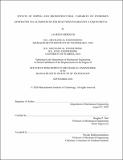| dc.contributor.advisor | Douglas P. Hart. | en_US |
| dc.contributor.author | Meroueh, Laureen. | en_US |
| dc.contributor.other | Massachusetts Institute of Technology. Department of Mechanical Engineering. | en_US |
| dc.date.accessioned | 2021-01-05T23:16:24Z | |
| dc.date.available | 2021-01-05T23:16:24Z | |
| dc.date.copyright | 2020 | en_US |
| dc.date.issued | 2020 | en_US |
| dc.identifier.uri | https://hdl.handle.net/1721.1/129067 | |
| dc.description | Thesis: Ph. D., Massachusetts Institute of Technology, Department of Mechanical Engineering, 2020 | en_US |
| dc.description | Cataloged from student-submitted PDF of thesis. | en_US |
| dc.description | Includes bibliographical references (pages [110]-127). | en_US |
| dc.description.abstract | Hydrogen has the potential to replace fossil fuels in numerous industrial sectors, considering its high energy density, ability to be used within our existing power or heating infrastructure, and lack of CO₂ emissions upon conversion of hydrogen's chemical energy into electricity. However, 96% of hydrogen is currently produced through steam methane reformation, which emits ~12 tons of CO₂ for every 1 ton of hydrogen produced. Consequently, hydrogen production accounts for roughly 830 million tons of annual global CO₂ emissions. Additionally, hydrogen storage can be impractical and expensive. The aluminum-water reaction presents itself as a hydrogen storage and generation solution. Without a passive oxide layer, aluminum will react with water to produce emission-free hydrogen, on-demand. | en_US |
| dc.description.abstract | We enable the reaction by harnessing eutectic gallium-indium (eGaIn), an ambient temperature liquid metal that permeates through aluminum grain boundaries, disrupting its passive oxide layer and inhibiting passivation of its grain surfaces. The focus of this work is on the investigation of the underlying aluminum-water reaction mechanism in the presence of eGaIn and on understanding the effects of using scrap aluminum (i.e. doped aluminum) as feedstock. Surprisingly, experiments show that silicon doping has a tremendous accelerating effect on the aluminum-water reaction in the presence of eGaIn. In combination with grain size manipulation, Si-doping can increase hydrogen evolution rates by two orders of magnitude compared to pure aluminum. Doping with magnesium significantly retards the aluminum-water reaction, resulting in relatively steady hydrogen evolution rates. It is also shown that eGaIn permeates through aluminum as a line dislocation front. | en_US |
| dc.description.abstract | These discoveries demonstrate that doping, grain refining and grain coarsening offer latitudes in the engineering of aluminum microstructures to tune hydrogen generation rates across three orders of magnitude and to tune the reaction efficiency. Using the results of this work, I provide a guide to the design/selection of aluminum for controllable hydrogen generation according to application. Lastly, while the corrosion of aluminum and its commercial alloys has been historically studied, results of this work show that the redox behavior of aluminum in the presence of eGaIn strays from what can be understood within the classical corrosion (galvanic theory) framework. | en_US |
| dc.description.statementofresponsibility | by Laureen Meroueh. | en_US |
| dc.format.extent | 127 pages | en_US |
| dc.language.iso | eng | en_US |
| dc.publisher | Massachusetts Institute of Technology | en_US |
| dc.rights | MIT theses may be protected by copyright. Please reuse MIT thesis content according to the MIT Libraries Permissions Policy, which is available through the URL provided. | en_US |
| dc.rights.uri | http://dspace.mit.edu/handle/1721.1/7582 | en_US |
| dc.subject | Mechanical Engineering. | en_US |
| dc.title | Effects of doping and microstructural variables on hydrogen generated via aluminum-water reactions enabled by a liquid metal | en_US |
| dc.type | Thesis | en_US |
| dc.description.degree | Ph. D. | en_US |
| dc.contributor.department | Massachusetts Institute of Technology. Department of Mechanical Engineering | en_US |
| dc.identifier.oclc | 1227042350 | en_US |
| dc.description.collection | Ph.D. Massachusetts Institute of Technology, Department of Mechanical Engineering | en_US |
| dspace.imported | 2021-01-05T23:16:23Z | en_US |
| mit.thesis.degree | Doctoral | en_US |
| mit.thesis.department | MechE | en_US |
